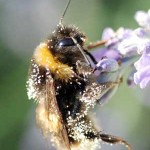Bees – and the weather.

Bees are important pollinators, especially for crops like apples. The UK apple market is estimated at some £320 M per annum.
Though current estimates vary, it is pretty much certain that this year’s apple harvest will be down, perhaps only 50% of that of a ‘normal’ year. Though the trees produced blossom in plenty and all looked good for a ‘bumper harvest’ – it then rained and rained.
Because of the weather, there were few bees, bumblebees or other pollinating insects. This has not been a good year for bees (or indeed, bumblebees). Why?
 Bees cannot forage in heavy rain
Bees cannot forage in heavy rain- The rain fills the flowers with water – so that bees cannot acces the nectar or the flower
- Flooding has destroyed hives and nests
- Low temperatures and rain affect the breeding behaviour of the queens – who need sun, warmth and still (preferably little or no wind) to ‘encourage' them to leave the hives / nests and mate
- The lack of foraging / honey production will probably affect the ability of the colonies to survive the winter and begin breeding next Spring.
Bees have been affected by parasites such as varroa and nosema, and pesticides such as the neonicotinoids, how their numbers / hives will been affected by the recent weather remains to be seen.
The weather that we have experienced this Spring and Summer has been linked by some to a rise in the temperature of the world’s oceans. The temperature of the Atlantic (where most of the weather systems that affect Europe form) has risen by some 0.5oC. This represents an enormous heat store that may have changed the ocean currents and weather patterns.
Comments are closed for this post.
Discussion
[…] change: more extreme weather events, e.g. heavy rainfall which can lead to flooding of bumblebee nests / hibernation […]
[…] on how the weather was affecting bees, butterflies and bumblebees, and how this in turn was affecting fruit crops etc. Fortunately, the picture seems to be somewhat better this year – despite the extended […]
[…] into flower, but the subsequent wet and colder weather meant that pollinators were not active (bumblebees in particular require warm, dry weather) and fruit formation was poor. The present cold weather […]
[…] Bees and bumblebees struggle in rainy weather – they cannot forage, nor can they complete their nuptial dance – the queens mate on the wing. As they could not forage for pollen and nectar so the pollination of fruit crops has been affected; the heavy downpours of rain also had a deleterious effect on the blossom. The production of honey in hives / nests / colonies has been dramatically affected – as bees have struggled to forage and find suitable flowers. […]
[…] to bees, again ~ by Chris Further to the woodlands post about ‘bees and weather’, the British Beekeepers Association has announced that honey yields from hives are substantially […]
More news on bees and the weather !
http://www.bbc.co.uk/news/uk-19337612
many acres of native wild plants are lost every year due to the poinless and incessant mowing of our roadside verges. Here in West sussex, we have hundreds of miles of beautiful verges with many species of wild flowers, an invaluable source of food and habitat for bees and all other insects. It is hard to find a good reason for this destruction. In many cases, the mowing goes right to the hedge even on a very wide verge. There are at least four cuts per year, resulting sometimes in what looks like a lawn. Mown grass is nigh on useless for insects, providing no food or habitat. It seems there is a desire to suburbanise even in the depths of the countryside.
As woodland owners there is a great deal we can do to help bees. Coppice rotations allow the presence of flowering plants in the first year or two after felling, and we can sow high nectar value wild flowers like Rosebay Willowherb, and allow bramble thickets to develop. Letting light in permanantly by making and maintaining generous rides and glades allows flowers a space. Some trees are much better than others for bees. the male Willows supply plentiul early pollen, flowering Chestnuts, Sycamores and especially Limes supply good amounts of nectar. Hawthorn and Blackthorn are good early sources, and supply good berries for winter bird food too. Holly and Ivy are both excellent berry bearers, Holly holding its fruit right through till spring, Ivy supplying a large late nectar source for many different insects. The greatest pressure on bees and butterflies is lack of forage, as agricultural practices have removed hedges and rough ground, coppice cutting has almost ceased, and wildflower hay meadows have been lost. Reversing that dcline is the best way to help all sorts of bees and butterflies, and other important insects, and it helps birds and small mammals equally. Close canopy woodlands are not bee-friendly. Let in the life-giving light, and plant for bees!
More research could be done to alleviate some of these problems:
e.g the types of sugars and pollen required for healthy bees, and thus the possibility of relative substitute foods in times of bee stress.
A continued working and upgrading of knowledge of botany in relation to bees pays dividends for keepers and bees alike.
Some beekeepers are aware of:
Siting hives away from area subject to flooding.
Growing flowers and shrubs in the more sheltered areas nearer hives.
Placing sugar feeders in hives in times of heavy prolonged rain or inclement weather.

I like your information . I would like to purchase plant seed to grow plants that catch insects. I would like to keep Bees in woodland. Regards I Grazier
Ivan Grazier
12 March, 2016